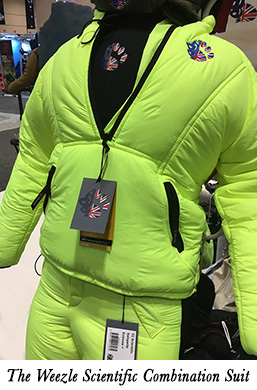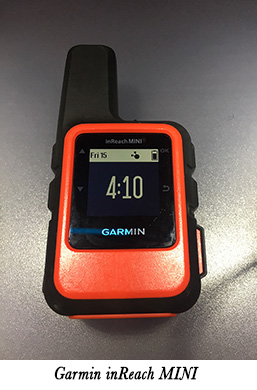A Taste of the DEMA Show November 2019Contents of this Issue: Iberostar, Dressel Divers, Cozumel and Playa del Carmen Quino del Guardián, Sea of Cortés, Mexico Head/Mares Discovers the Reason for Full Face Mask Deaths A Row Erupts Over a Great White Shark’s Death Climate Change is Killing Clownfish The Rich Sounds of Healthy Reefs May Save Them Harrowing Tales from the Red Sea Aggressor I Fire Lithium-ion Battery Safety: Industry Experts Give Their Points of View U.S. Coast Guard Regulations under Criticism in Wake of the Conception Tragedy A Taste of the DEMA Show November 2019 Editorial Office: Ben Davison Publisher and Editor Undercurrent 3020 Bridgeway, Suite 102 Sausalito, CA 94965 not much in the way of new gear from the January, 2020 issue of Undercurrent
Every year, people from all elements of the diving industry meet at the Diving Equipment and Marketing Association show to exchange ideas, promote diving destinations, display new products, and tell stories over drinks. It's time when people in the industry from all over the world can get together, and this year it was held in Orlando in mid-November. So what new products were displayed at the show? Well, not a lot, actually. Scubapro was notable by its total absence, and few other manufacturers had anything really revolutionary at their booths. Familiar products were refined or simply refreshed. For example, Cressi showed its all-new Cressi AC25 high-performance piston-type regulator with a first-stage that looked remarkably reminiscent of the Scubapro Mk20/25 series. (cressi.com) Divewear News Perhaps the return of colored wetsuits, such as those from Problue (www.problue.com.tw), after a decade or divers dressing in nothing but black, has been prompted by the recent popularity of brightly colored masks and fins, epitomized by those from French manufacturer Beuchat. (beuchat-diving.com) Even Shearwater offered colored straps for its otherwise serious technical diver's Shearwater Teric computer/watch. (shearwater.com) Otherwise, this Undercurrent reporter had to trawl the aisles searching out what might be interesting, and I wasn't helped by a dearth of anything new in the New Product Showcases.
Another British company, Weezle, claims to make possibly the best drysuit undersuits in the world, combining Swiss technology with British workmanship. They displayed the Weezle Scientific combination suit in a bright yellow/lime color that, so brightly colored, ensures there's no danger of the wearer getting accidentally run down while walking about in it. (weezle.co.uk) Henderson stepped up technologically with a range of suits made from 'greenprene,' a plant-based insulating material -- as opposed to petroleum-based neoprene -- ranging in thicknesses from 1mm to 7mm. The material has been tested and approved by the U.S. Dept of Agriculture as a 'biobased' and 'biopreferred' product. The wetsuits also use recycled laminates and a durable abrasion-resistant exterior fabric made from recycled plastic water bottles. (hendersonusa.com)
Of particular interest to Undercurrent readers, Garmin revealed the Garmin inReach MINI, a device for ensuring that you get picked up even if you surface far from your dive boat. Initially aimed at yachtsmen, and as such, waterproof for close-to-surface use, an underwater housing for divers is rated to 330-feet. Communicating via its base in Texas using the Iridium satellite network, it allows lost divers to confirm they are safely at the surface, to reveal their GPS position, and even to have a two-way text conversation with first-responders using pre-written stored messages that are selected as appropriate. Most importantly, the unit is so compact at half the height of a soda can and a frontal area around the size of a credit card, it's no imposition to carry it. It's expected to sell for around $300. (garmin.com) Underwater Photography Equipment Underwater photography supplies have become a major feature of the DEMA show in recent years, and as usual, all the major manufacturers of underwater photo equipment were there. The Chinese company, Nauticam, is attempting to dominate this sector, continually introducing new products for a vast range of cameras. This time it showed the new version of its Nauticam WW conversion lens, specifically intended for use with compact cameras. Nauticam also displayed a prototype of its endoscopic lens, suitable for recording the tiniest subjects in the most inaccessible places. (nauticam.com) In the underwater strobe category, the Ikelite DS-161 has been updated with a bigger circular flash tube for significantly greater output and a wider beam angle and now offers converters for use with Nikon, Sony, Panasonic and Olympus cameras. (ikelite.com) Seacam revealed its Seaflash 160 Digital strobe. (seacam.com)
Backscatter showed its diminutive Mini Flash Underwater Strobe MF-1, suitable for mounting on top of a housing and intended for use with compact cameras (backscatter.com) while the Seafrogs ST-100 Pro strobe was devoid of too much complication to keep the price point low. (seafrogs.com.hk) Technical Diving International's 25th Anniversary
TDI certainly did a lot to popularize technical diving (that is, venturing beyond the 130-feet depth-limit of recreational divers), and this was reflected at the DEMA show in the number of rebreathers that have become mainstream. Dräger launched a semi-closed-circuit unit at about the same time TDI started, but it soon faded to oblivion. The Hollis Explorer SCR unit that received so much fanfare, was soon dropped when Huish took over the troubled Hollis/Oceanic empire, confirming the market resistance to the semi-closed solution that gives no advantages in deco obligation but can extend gas duration. Notwithstanding this, Mares launched the Mares Horizon SCR at this DEMA, presumably hoping that association with Paul Raymaekers, designer of the successful rEvo closed-circuit rebreather (a product since taken over by Mares), will give it the necessary credibility. Time will tell. (https://www.mares.com/en-IC/horizon)
It weighs 10 pounds and is said to be good for an hour underwater. The manufacturer claims it's good for 138-feet deep, and as Bret Gilliam wryly asked, "What could possibly go wrong?" We didn't have to wait long to find out. The demonstration later in the DEMA display pool fell flat on its face when the unfortunate volunteer diver collapsed and had to be rescued, later to be taken away by ambulance. It's probably only a one-DEMA product. (aquabreather.com) -- John Bantin |

I want to get all the stories! Tell me how I can become an Undercurrent Online Member and get online access to all the articles of Undercurrent as well as thousands of first hand reports on dive operations world-wide
| Home | Online Members Area | My Account |
Login
|
Join
|
| Travel Index |
Dive Resort & Liveaboard Reviews
|
Featured Reports
|
Recent
Issues
|
Back Issues
|
|
Dive Gear
Index
|
Health/Safety Index
|
Environment & Misc.
Index
|
Seasonal Planner
|
Blogs
|
Free Articles
|
Book Picks
|
News
|
|
Special Offers
|
RSS
|
FAQ
|
About Us
|
Contact Us
|
Links
|
3020 Bridgeway, Ste 102, Sausalito, Ca 94965
All rights reserved.

 The Fourth Element Surface wetsuit is said to finally be available from this British manufacturer, despite being announced last year. It's the world's first certified sustainable wetsuit made from reclaimed plastic. At 3-4mm thick, it's only suitable for use in warmer waters and didn't look too robust, but it's certainly a step in the right direction, even though it only comes in last year's somber black. For cold-water divers, Fourth Element also showed the HALO A°R undersuit that, despite its name, actually contains no rare gas. (
The Fourth Element Surface wetsuit is said to finally be available from this British manufacturer, despite being announced last year. It's the world's first certified sustainable wetsuit made from reclaimed plastic. At 3-4mm thick, it's only suitable for use in warmer waters and didn't look too robust, but it's certainly a step in the right direction, even though it only comes in last year's somber black. For cold-water divers, Fourth Element also showed the HALO A°R undersuit that, despite its name, actually contains no rare gas. ( For When You Are Lost
For When You Are Lost It was the 25th anniversary of TDI/SDI, the technical training agency founded by Bret Gilliam, among others, who was seen strolling the show (a rare sight indeed) and looking more and more like an English Tudor monarch. Mitch Skaggs, another founder, had lost his trademark military flat-top haircut and was unrecognizable in the guise of a '70s boy-band member with a floppy blonde look. TDI's celebration party at the Bahama Breeze was oversubscribed with around 1100 noisy enthusiasts in a far-too-crowded venue. (
It was the 25th anniversary of TDI/SDI, the technical training agency founded by Bret Gilliam, among others, who was seen strolling the show (a rare sight indeed) and looking more and more like an English Tudor monarch. Mitch Skaggs, another founder, had lost his trademark military flat-top haircut and was unrecognizable in the guise of a '70s boy-band member with a floppy blonde look. TDI's celebration party at the Bahama Breeze was oversubscribed with around 1100 noisy enthusiasts in a far-too-crowded venue. ( Star of the show had to be the Russian Hydroid Aquabreather closed-circuit rebreather. Looking like something created by the imagination of Jules Verne, it's a rebreather entirely enclosed within a diving-helmet-like device. This includes a head-up display and two regenerative scrubber cartridges, both the size of Coke cans, and, according to the salesman, a tiny high-pressure O2 gas supply. The website says, "There are no oxygen cylinders in Aquabreather," which caused some confusion. (It was probably something lost in translation.)
Star of the show had to be the Russian Hydroid Aquabreather closed-circuit rebreather. Looking like something created by the imagination of Jules Verne, it's a rebreather entirely enclosed within a diving-helmet-like device. This includes a head-up display and two regenerative scrubber cartridges, both the size of Coke cans, and, according to the salesman, a tiny high-pressure O2 gas supply. The website says, "There are no oxygen cylinders in Aquabreather," which caused some confusion. (It was probably something lost in translation.)